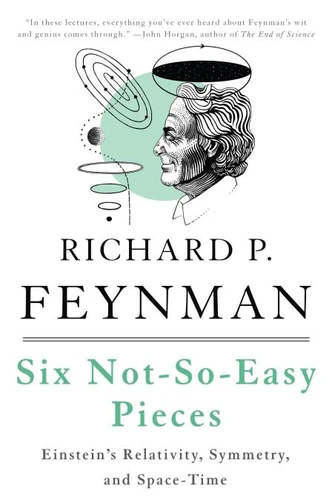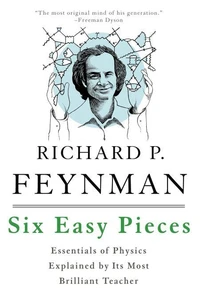Six Not - So - Easy Pieces. Einstein's Relativity, Symmetry, and Space - Time
Par : , ,Formats :
Disponible dans votre compte client Decitre ou Furet du Nord dès validation de votre commande. Le format ePub protégé est :
- Compatible avec une lecture sur My Vivlio (smartphone, tablette, ordinateur)
- Compatible avec une lecture sur liseuses Vivlio
- Pour les liseuses autres que Vivlio, vous devez utiliser le logiciel Adobe Digital Edition. Non compatible avec la lecture sur les liseuses Kindle, Remarkable et Sony
- Non compatible avec un achat hors France métropolitaine
 , qui est-ce ?
, qui est-ce ?Notre partenaire de plateforme de lecture numérique où vous retrouverez l'ensemble de vos ebooks gratuitement
Pour en savoir plus sur nos ebooks, consultez notre aide en ligne ici
- Nombre de pages184
- FormatePub
- ISBN978-0-465-02528-2
- EAN9780465025282
- Date de parution21/03/2011
- Protection num.Adobe DRM
- Infos supplémentairesepub
- ÉditeurBasic Books
Résumé
Learn about Einstein's theory of relativity from a physics Nobel laureate and "one of the greatest minds of the twentieth century" (New York Review of Books) in six memorable lessons It was Richard Feynman's outrageous and scintillating method of teaching that earned him legendary status among students and professors of physics. From 1961 to 1963, Feynman delivered a series of lectures at the California Institute of Technology that revolutionized the teaching of physics. In Six Not-So-Easy Pieces, taken from these famous Lectures on Physics, Feynman delves into one of the most revolutionary discoveries in twentieth-century physics: Einstein's theory of relativity.
The idea that the flow of time is not a constant, that the mass of an object depends on its velocity, and that the speed of light is a constant no matter what the motion of the observer, at first seemed shocking to scientists and laymen alike. But as Feynman shows, these tricky ideas are not merely dry principles of physics, but things of beauty and elegance. No one - not even Einstein himself - explained these difficult, anti-intuitive concepts more clearly, or with more verve and gusto, than Feynman.
Filled with wonderful examples and clever illustrations, Six Not-So-Easy Pieces is the ideal introduction to the fundamentals of physics by one of the most admired and accessible physicists of all time. "There is no better explanation for the scientifically literate layman." -Washington Post Book World
The idea that the flow of time is not a constant, that the mass of an object depends on its velocity, and that the speed of light is a constant no matter what the motion of the observer, at first seemed shocking to scientists and laymen alike. But as Feynman shows, these tricky ideas are not merely dry principles of physics, but things of beauty and elegance. No one - not even Einstein himself - explained these difficult, anti-intuitive concepts more clearly, or with more verve and gusto, than Feynman.
Filled with wonderful examples and clever illustrations, Six Not-So-Easy Pieces is the ideal introduction to the fundamentals of physics by one of the most admired and accessible physicists of all time. "There is no better explanation for the scientifically literate layman." -Washington Post Book World
Learn about Einstein's theory of relativity from a physics Nobel laureate and "one of the greatest minds of the twentieth century" (New York Review of Books) in six memorable lessons It was Richard Feynman's outrageous and scintillating method of teaching that earned him legendary status among students and professors of physics. From 1961 to 1963, Feynman delivered a series of lectures at the California Institute of Technology that revolutionized the teaching of physics. In Six Not-So-Easy Pieces, taken from these famous Lectures on Physics, Feynman delves into one of the most revolutionary discoveries in twentieth-century physics: Einstein's theory of relativity.
The idea that the flow of time is not a constant, that the mass of an object depends on its velocity, and that the speed of light is a constant no matter what the motion of the observer, at first seemed shocking to scientists and laymen alike. But as Feynman shows, these tricky ideas are not merely dry principles of physics, but things of beauty and elegance. No one - not even Einstein himself - explained these difficult, anti-intuitive concepts more clearly, or with more verve and gusto, than Feynman.
Filled with wonderful examples and clever illustrations, Six Not-So-Easy Pieces is the ideal introduction to the fundamentals of physics by one of the most admired and accessible physicists of all time. "There is no better explanation for the scientifically literate layman." -Washington Post Book World
The idea that the flow of time is not a constant, that the mass of an object depends on its velocity, and that the speed of light is a constant no matter what the motion of the observer, at first seemed shocking to scientists and laymen alike. But as Feynman shows, these tricky ideas are not merely dry principles of physics, but things of beauty and elegance. No one - not even Einstein himself - explained these difficult, anti-intuitive concepts more clearly, or with more verve and gusto, than Feynman.
Filled with wonderful examples and clever illustrations, Six Not-So-Easy Pieces is the ideal introduction to the fundamentals of physics by one of the most admired and accessible physicists of all time. "There is no better explanation for the scientifically literate layman." -Washington Post Book World










